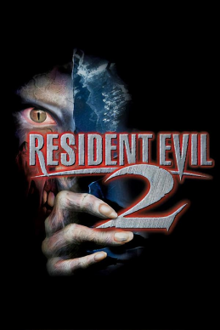
Back ريزدنت إيفل 2 Arabic ريزدنت ايفل 2 ARZ Resident Evil 2 Azerbaijani Resident Evil 2 Catalan Resident Evil 2 Czech Resident Evil 2 Danish Resident Evil 2 German Resident Evil 2 Greek Resident Evil 2 Spanish رزیدنت ایول ۲ Persian
| Resident Evil 2 | |
|---|---|
 North American cover art | |
| Developer(s) | Capcom[a] |
| Publisher(s) | |
| Director(s) | Hideki Kamiya |
| Producer(s) | Shinji Mikami |
| Programmer(s) | Yasuhiro Anpo |
| Artist(s) |
|
| Writer(s) | Noboru Sugimura |
| Composer(s) |
|
| Series | Resident Evil |
| Platform(s) | PlayStation, Windows, Nintendo 64, Dreamcast, GameCube, Game.com |
| Release | January 21, 1998
|
| Genre(s) | Survival horror |
| Mode(s) | Single-player |
Resident Evil 2[b] is a 1998 survival horror video game developed and published by Capcom for the PlayStation. The player controls rookie cop Leon S. Kennedy and college student Claire Redfield, who must escape Raccoon City after its citizens are transformed into zombies by a biological weapon two months after the events of the original Resident Evil. The gameplay focuses on exploration, puzzles, and combat; the main difference from its predecessor are the branching paths, with each player character having unique storylines, partners and obstacles.
Resident Evil 2 was produced by Resident Evil director Shinji Mikami, directed by Hideki Kamiya, and developed by a team of approximately 50 across 21 months. The initial version, commonly referred to as Resident Evil 1.5, differs drastically; it was canceled at approximately two thirds completion because Mikami decided it was inadequate. The final design introduced a more cinematic presentation.
Resident Evil 2 received acclaim for its atmosphere, setting, graphics, audio, scenarios, overall gameplay, and its improvements over the original game, but with some criticism towards its controls, voice acting, and certain gameplay elements. It is widely listed among the best video games ever made. It is the best-selling Resident Evil game for a single platform at more than 6 million copies sold across all platforms. It was ported to Windows, Nintendo 64, Dreamcast, and GameCube, and a modified 2.5D version was released for the Game.com handheld. The story of Resident Evil 2 was retold and built upon in several later games, and has been adapted into a variety of licensed works. It was followed by Resident Evil 3: Nemesis in 1999. A remake was released for PlayStation 4, Windows, and Xbox One in 2019.
- ^ "EuroGold". Gone Gold. Archived from the original on February 10, 2001. Retrieved December 25, 2023.
- ^ "New Releases of 1999". February 3, 2001. Archived from the original on February 3, 2001. Retrieved October 2, 2023.
Cite error: There are <ref group=lower-alpha> tags or {{efn}} templates on this page, but the references will not show without a {{reflist|group=lower-alpha}} template or {{notelist}} template (see the help page).